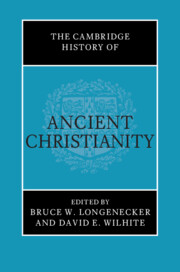Book contents
- The Cambridge History of Ancient Christianity
- The Cambridge History of Ancient Christianity
- Copyright page
- Contents
- Figures
- List of Contributors
- Editors’ Preface
- Part I Contested Contexts
- Part II Contested Figures
- Part III Contested Heritage
- Part IV Contested Cultures
- Part V Contested Beliefs
- 19 Contesting Creator and Creation
- 20 The Trinity in the Making
- 21 Resurrection, Transformation, and Deification
- 22 The Eucharist in the First Three Centuries
- 23 Office, and Appointment to Office, in Early Christian Circles
- Part VI Contested Bodies
- Ancient Sources
- Modern Authors
- References
23 - Office, and Appointment to Office, in Early Christian Circles
from Part V - Contested Beliefs
Published online by Cambridge University Press: 23 August 2023
- The Cambridge History of Ancient Christianity
- The Cambridge History of Ancient Christianity
- Copyright page
- Contents
- Figures
- List of Contributors
- Editors’ Preface
- Part I Contested Contexts
- Part II Contested Figures
- Part III Contested Heritage
- Part IV Contested Cultures
- Part V Contested Beliefs
- 19 Contesting Creator and Creation
- 20 The Trinity in the Making
- 21 Resurrection, Transformation, and Deification
- 22 The Eucharist in the First Three Centuries
- 23 Office, and Appointment to Office, in Early Christian Circles
- Part VI Contested Bodies
- Ancient Sources
- Modern Authors
- References
Summary
In an earlier essay on the interplay between charisma and office, I listed the questions I had left unanswered:
the origin of bishops, deacons, and presbyters, the precise extent and scope of their duties (as part of which we should pose the, as much unasked as unanswered, question of how bishops and/or presbyters come to have the exclusive right of presidency at the Eucharist), the fate of the teacher in the second century, and the manner in which, despite the opposition of such figures as Clement, Hermas and Ignatius, the episcopate takes on an intellectual role in the second century.1
- Type
- Chapter
- Information
- The Cambridge History of Ancient Christianity , pp. 536 - 558Publisher: Cambridge University PressPrint publication year: 2023



